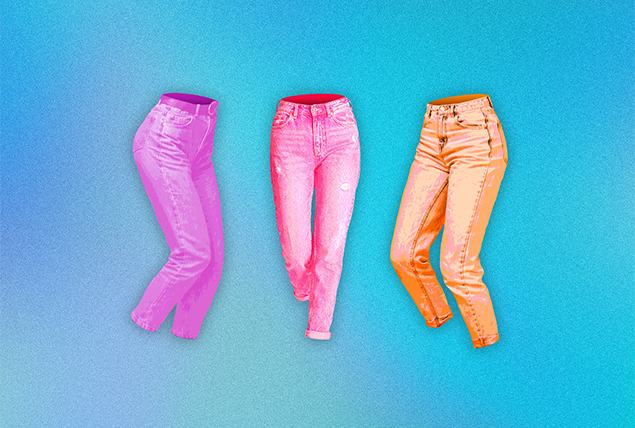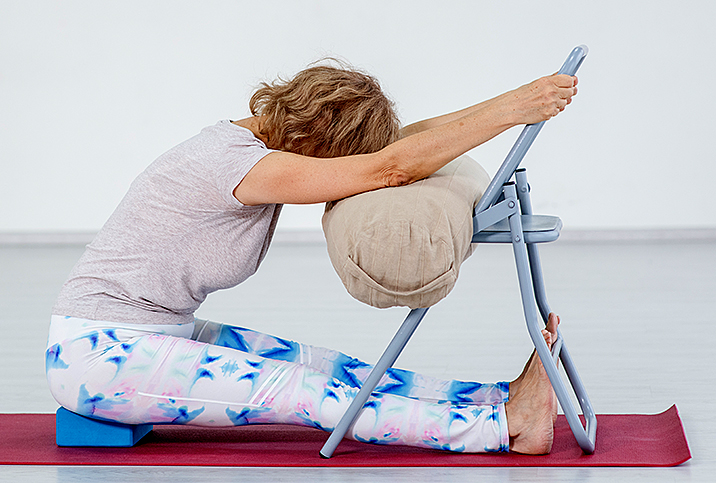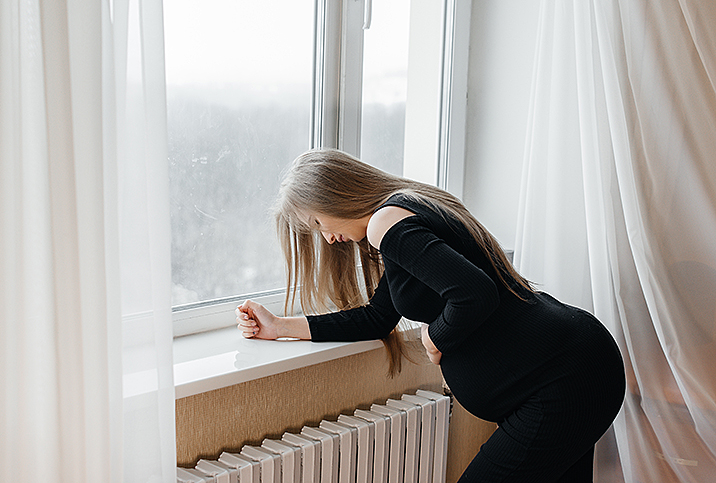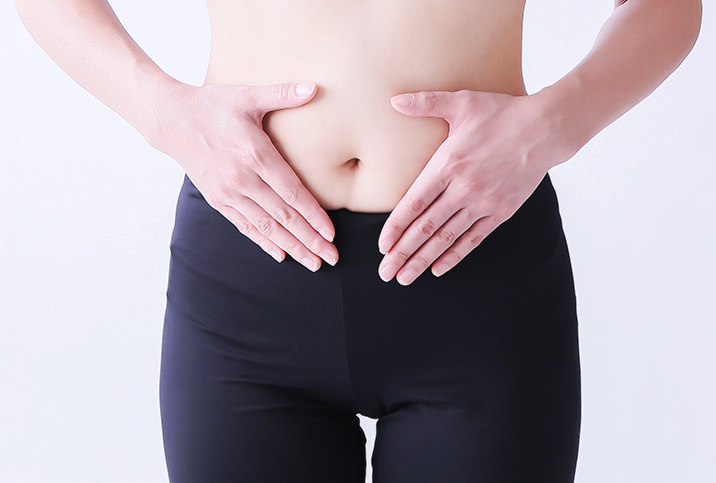Can High-Waisted Pants Cause Pelvic Floor Issues?

Popular and flattering, high-waisted pants have joined a group of clothing often deemed "unhealthy." Some people claim high-waisted pants, along with corsets and other tight clothes, can cause health problems, specifically with the pelvic floor.
What's the deal with your pelvic floor?
Pelvic floor issues, in general, are fairly common in women, according to Kandis B. Daroski, D.P.T., a physical therapist at Hinge Health in Canfield, Ohio:
- Nearly 1 in 4 women have a pelvic floor disorder.
- Up to half of women report some amount of urine leakage.
- Thirty-five percent of postpartum women and 7.5 percent of women overall say sex is painful.
- Up to 15 percent of women are affected by chronic pelvic pain.
- Nearly half of women have pelvic organs that have prolapsed.
While pelvic floor issues are common, they are not normal, Daroski emphasized.
"Although these issues are generally not dangerous, symptoms like urinary leakage, needing to urinate urgently, pelvic pressure and pain are a big red flag that something is going on with your pelvic floor that you shouldn't ignore," Daroski said. "Imagine if we applied this 'common means normal' idea to other health conditions. Diabetes is common, but we don't accept it as normal. We treat it with exercise, nutrition, lifestyle modifications and medication," she added.
Can high-waisted pants cause problems with your pelvic floor? Or digestive issues? We talked to experts about the importance of keeping your pelvic floor muscles healthy and the potential dangers of high-waisted pants.
High-waisted pants and your pelvic floor
Your pelvic floor is the group of muscles that support the organs in your pelvis, such as your bladder, bowel and internal reproductive organs, and keep them in place. These muscles assist peeing, pooping, birthing and having sex. Keeping your pelvic floor strong is crucial for overall health.
What do high-waisted pants have to do with it? Some people claim that the tightness of these pants squeezes your organs and weakens your pelvic floor.
"It is possible that restrictive, high-waisted pants can be a factor in pelvic floor issues, but it is unlikely to be the whole story behind the symptoms," Daroski said.
The actual issue regarding tight pants
Let's see how the diaphragm and pelvic floor work together.
"Your diaphragm, spinal, abdominal and pelvic floor muscles interconnect and work together to form a pressurized compartment similar to a balloon. As you breathe in, the diaphragm expands, the lungs fill with air and the abdominal and pelvic floor muscles must also gently lengthen," Daroski explained.
"External pressure and compression around the abdomen and waist can influence what happens at the pelvic floor muscles and the diaphragm," Daroski continued. "Think of the balloon reference. If you cinch or squeeze the balloon at the center, more pressure goes into the top and bottom of the balloon. "This shift in pressure can cause an individual to change their breathing habits, encourage 'gripping' and weakness in the abdominal muscles, and place increased downward pressure on the pelvic organs, all of which can lead to pelvic floor dysfunction if occurring chronically," Daroski said. While it is possible that high-waisted pants could have a negative impact on the pelvic floor, it's unlikely.
"That is not going to happen by wearing these pants for a few hours a day," said Amir Marashi, M.D., an OB-GYN in Brooklyn, New York.
Typical wear is unlikely to cause any real health issues. To be extra careful, limit your use of tight pants to outings and change into less restrictive clothing when you get home.
High-waisted pants and your digestive system
Your digestive system may be another issue. If you've ever unbuttoned your pants after a particularly heavy meal (looking at you, Thanksgiving!), you understand the discomfort that tight, high-waisted pants can bring you. "The abdominal cavity is home to some pretty important organs. Wearing clothing that is extremely tight against your stomach can cause stomach discomfort, bloating and digestive issues," Daroski explained. "If your pants are too tight, the abdominal, pelvic floor and diaphragm muscles may not be able to contract and lengthen as freely as they should, which can lead to pelvic floor dysfunction such as constipation." Of course, it should be stated that scientific research is limited on this topic.
"There is no evidence, but many people have felt the discomfort after eating a heavy meal," said Kim Vopni, a pelvic health trainer, known as "the Vagina Coach," in Port Moody, British Columbia. "Bloating can inhibit function."
Keeping your pelvic floor healthy
Wear whatever you want, but if your focus is comfort, it may be time to ditch the high-waisted pants. They can potentially cause discomfort. Clothing options for pelvic floor health may be better suited for a happy body. "I do not like to discourage women from wearing what they like to wear, but of course, comfortable clothing is easy on all abdominal and pelvic organs," Marashi said. "[Try] wearing loose-fitting clothing and shoes. Also, comfortable fabric like cotton can help with the discomfort."
There are other considerations with tight clothing, too, such as mobility, Vopni noted.
"Tight skirts or pants will make us move differently, so we don't rip the seams, for instance. We benefit from a variety of movement that is not inhibited by restrictive clothing," Vopni said.
Improving pelvic floor function
Beyond clothing, you can keep your pelvic floor in optimal shape in several ways, starting with exercise. Staying generally active and healthy is crucial, as are targeted exercises such as Kegels.
“Pelvic floor exercise is essential even if you have no symptoms or signs of dysfunction," Vopni said. "The pelvic floor is responsible for our sexual response, organ support, continence, pelvic and spinal stability, yet we do not know or appreciate the need for targeted exercises to keep these muscles working optimally...especially as we age."
Daroski also suggested managing overall stress and practicing good toilet habits.
"Avoid pushing to empty your bladder, hovering while peeing and 'just-in-case peeing,' going when you do not actually have the urge to go," Daroski said.
Knowing when to urinate can be tricky, as holding it for too long can potentially cause urinary tract infections (UTIs), but going too often can cause your bladder to indicate the need to urinate when it's not actually full.
It's also important to be mindful of your posture, Daroski added.
"How we sit, stand and move throughout our day can affect pelvic floor strength and flexibility. For example, sitting in a slouched position can lead to a weakened pelvic floor, and standing with too much arch in the lower back and pelvis can lead to weak gluteal muscles and a pelvic floor that is tight and weak," Daroski said.
When to see a pelvic floor therapist
While there is much you can do on your own to keep your pelvic floor healthy, sometimes it's best to get expert advice. Vopni suggested women see a pelvic floor physical therapist once a year to ensure their pelvic floor is in good shape.
A pelvic floor therapist can assess the health of your pelvic floor muscles and give you exercises and lifestyle changes (that may or may not include advice on high-waisted clothing) specifically targeted for your situation.
The bottom line
With roughly 24 percent of American women experiencing pelvic floor issues, it's possible the problem goes far beyond the occasional tight pants. If you have concerns regarding your pelvic floor, speak with your healthcare professional. Don't have a doctor? Let Giddy Telehealth connect you to hundreds of medical professionals in various specialties. Many offer same-day appointments and video consultations.


















